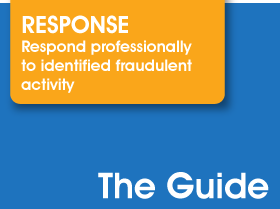Welcome to the FMRC guide
How it works
The key elements of fraud risk management are:
 Prevention: Identify the main risks to your organisation and build the right governance and management structures supported by policies and procedures to prevent your organisation from becoming a victim of fraud;
Prevention: Identify the main risks to your organisation and build the right governance and management structures supported by policies and procedures to prevent your organisation from becoming a victim of fraud;
 Deterrence: Implement an anti-fraud culture supported by relevant training and communication to deter fraud;
Deterrence: Implement an anti-fraud culture supported by relevant training and communication to deter fraud;
 Response: Implement systems and procedures to detect the early warning signs of fraud and prepare for fraud by having an up-to-date response plan.
Response: Implement systems and procedures to detect the early warning signs of fraud and prepare for fraud by having an up-to-date response plan.
This Resource Centre provides our unique step by step guidance on these key elements providing you with an easy route to manage fraud risks across your organisation. Each section contains a number of topics with a step by step guide through each one. It is not necessary to fully complete each element in turn but rather each element and section can be developed in unison according to your needs.
Before starting on these however we would recommend you get familiar with our approach to fraud risk management through our short 3 min video.
If you are a more experienced counter fraud or audit professional and know what you specifically need to access, then use our links and menu system to access the relevant content. If however you are relatively new to this task or a non-fraud specialist then you may find it easier to access our Fraud Management Organisational Capability Assessment tool. This tool will enable you to assess which aspects you need to focus on and you can then come back to the guide to access more detailed guidance on those specific areas.
We have also identified those resources that might be more relevant to specific professional groups which you can access from the links below:
The term “fraud” is usually used to describe theft of assets, misuse of funds or by more complicated crimes such as false accounting or the supply of false information. Many of the offences referred to as fraud are covered by the Fraud Act 2006, The Bribery Act 2010, and the Theft Act 1968. The term fraud in this guide is used to describe any economic crime such as fraud, bribery, corruption, money laundering, terrorist financing under the Proceeds of Crime Act, deception, forgery, extortion, theft, conspiracy, embezzlement, misappropriation of assets, false representations and concealment of material facts.
Need help?
If you need help please visit our members support page or email support@fraudmanagementresourcecentre.com








